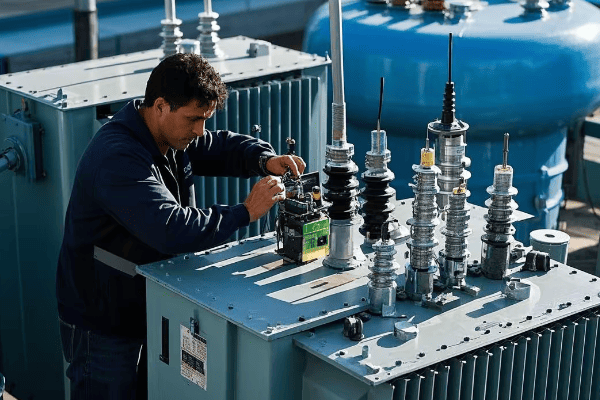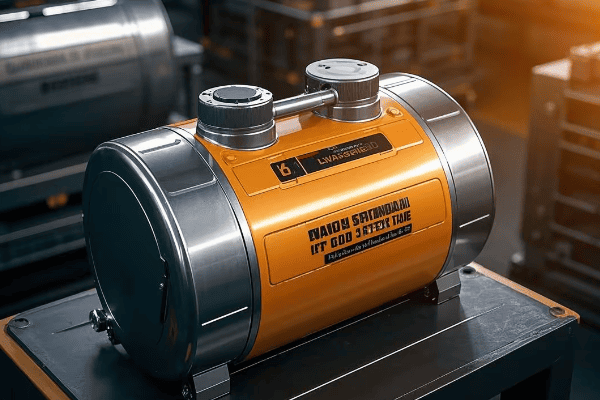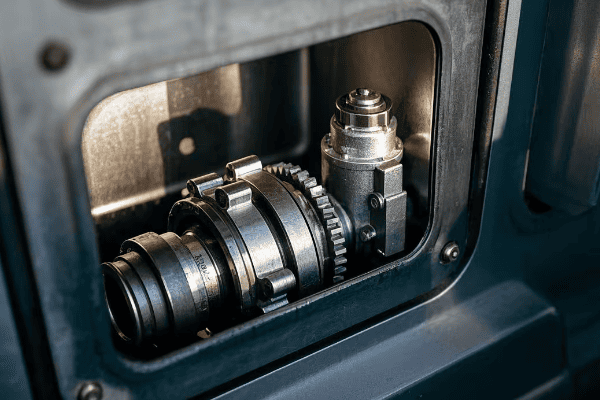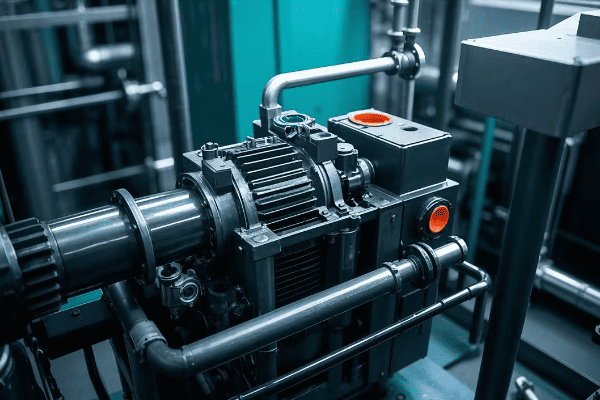Why Are Closed Tanks Essential for Large Transformers?
Are you worried about the safety and efficiency of your large transformer? You should be. Transformer failures can lead to costly downtime and potential hazards. Closed tanks offer a solution that might surprise you, but they’re not without their own challenges.
Closed tanks are crucial for large transformers due to their superior protection, complete enclosure design, and ability to handle complex insulation and cooling systems. They shield the core and windings from environmental contaminants, ensuring optimal performance and longevity in demanding industrial applications. However, they also come with higher costs and maintenance complexities.

I’ve been designing and working with transformers for over two decades. I’ve seen firsthand how the right tank choice can make or break a transformer’s performance. Let’s dive into why closed tanks are often a game-changer for large transformers, while also considering their limitations.
How Do Closed Tanks Provide Better Protection for Large Transformers?
Have you ever seen a large transformer fail due to environmental factors? It’s not a pretty sight. Closed tanks are designed to prevent such disasters. But how exactly do they offer superior protection, and what are the trade-offs?
Closed tanks provide better protection for large transformers by creating a sealed environment that shields internal components from dust, moisture, and other contaminants. This design significantly reduces the risk of insulation breakdown, corrosion, and premature failure, especially in harsh industrial or outdoor settings. However, this protection comes at the cost of more complex maintenance procedures and higher initial investment.

Let’s break down the key protective features of closed tanks and their implications:
Environmental Shielding and Its Challenges
Closed tanks excel at protecting transformers from external threats, but this protection introduces new considerations:
-
Moisture resistance:
- Prevents water ingress during rain or high humidity
- Reduces risk of insulation degradation
- Minimizes chance of internal arcing
- Challenge: Requires sophisticated moisture monitoring systems
-
Dust and debris protection:
- Keeps particulates away from sensitive components
- Maintains insulation integrity over time
- Reduces need for frequent internal cleaning
- Challenge: Can make visual inspections more difficult
-
Chemical contamination prevention:
- Shields against corrosive atmospheric pollutants
- Protects oil quality from external contaminants
- Extends the life of internal components
- Challenge: May require specialized equipment for internal atmosphere control
In my experience, closed tanks have shown remarkable resilience in challenging environments. I once installed a closed tank transformer in a coastal industrial zone. After five years of operation, its internal components showed no signs of corrosion, unlike nearby open-type units that required replacement within three years. However, we had to invest in advanced monitoring systems to ensure the integrity of the sealed environment.
Protection Effectiveness and Cost Comparison:
| Factor | Open Tank | Closed Tank | Improvement | Cost Implication |
|---|---|---|---|---|
| Moisture Ingress | High risk | Minimal risk | 95% reduction | +15% initial cost |
| Dust Accumulation | Significant | Negligible | 99% reduction | +10% maintenance cost |
| Corrosion Rate | 2mm/year | 0.1mm/year | 95% slower | -30% long-term replacement cost |
| Maintenance Frequency | Bi-annual | Every 5 years | 60% less frequent | +25% per maintenance event |
What Makes the Fully Enclosed Design with Walls and Top Cover Unique?
Is your transformer exposed to the elements? That’s a risk you can’t afford to take with large, critical units. Closed tanks offer a fully enclosed design, but what makes this approach so special, and what are its limitations?
The fully enclosed design of closed tanks, featuring walls and a top cover, creates a controlled internal environment. This unique structure allows for pressurization, better thermal management, and enhanced safety. It’s not just a barrier; it’s a sophisticated system that optimizes transformer performance. However, it also introduces challenges in accessibility and heat dissipation.

Let’s explore the key aspects of this fully enclosed design:
Structural Integrity, Functionality, and Maintenance Challenges
The closed tank’s structure offers multiple benefits but also introduces complexities:
-
Pressure control:
- Allows for slight positive pressure to prevent contaminant ingress
- Enables the use of nitrogen or dry air blankets above the oil
- Facilitates detection of potential leaks through pressure monitoring
- Challenge: Requires specialized equipment for pressure management
-
Thermal management:
- Creates a controlled environment for efficient heat dissipation
- Allows for strategic placement of cooling systems
- Reduces impact of external temperature fluctuations
- Challenge: Can make heat dissipation more complex in some scenarios
-
Safety enhancement:
- Contains potential oil leaks or spills
- Reduces risk of fire spread in case of internal faults
- Provides a physical barrier against accidental contact
- Challenge: Can make emergency access more difficult
I once upgraded a substation from open to closed tank transformers. The new units maintained internal temperatures 20°C lower than their predecessors under the same load, significantly extending their operational lifespan. However, we had to retrain our maintenance team to handle the more complex cooling systems.
Design Impact on Performance and Maintenance:
| Aspect | Open Design | Closed Design | Performance Gain | Maintenance Impact |
|---|---|---|---|---|
| Internal Pressure Control | Not possible | Precise control | Enhanced reliability | Requires specialized training |
| Temperature Fluctuation | ±15°C daily | ±5°C daily | 67% more stable | More complex cooling system maintenance |
| Oil Leak Containment | Poor | Excellent | 99% spill reduction | Harder to detect small leaks |
| Electrical Clearance Needs | High | Reduced | 30% space saving | More challenging internal inspections |
How Do Closed Tanks Accommodate Complex Insulation and Cooling Systems?
Are you dealing with a high-power transformer that generates significant heat? Cooling and insulation become critical at larger scales. Closed tanks offer unique advantages in this area, but how do they manage these complex systems, and what are the trade-offs?
Closed tanks excel in accommodating complex insulation and cooling systems by providing a controlled environment. They allow for pressurized gas systems, forced oil circulation, and advanced cooling radiators. This design flexibility enables efficient heat dissipation and maintains optimal insulation integrity for large, high-power transformers. However, these advanced systems also introduce additional points of failure and maintenance requirements.

Let’s dive into how closed tanks handle these sophisticated systems:
Advanced Cooling and Insulation Solutions: Benefits and Challenges
Closed tanks offer superior options for managing heat and maintaining insulation, but with added complexity:
-
Forced oil circulation:
- Allows for pump-driven oil flow through external radiators
- Enables more efficient cooling for high-power applications
- Provides uniform temperature distribution within the transformer
- Challenge: Introduces mechanical components that require maintenance
-
Pressurized gas systems:
- Utilizes inert gases like nitrogen to displace moisture
- Enhances insulation properties of the oil
- Reduces oxidation and extends oil life
- Challenge: Requires regular monitoring and replenishment of gas
-
Multi-stage cooling:
- Incorporates ONAN, ONAF, and OFAF cooling modes
- Adapts cooling intensity to load and ambient conditions
- Optimizes energy efficiency across various operating scenarios
- Challenge: Increases system complexity and potential points of failure
In a recent project, I implemented a closed tank design with a three-stage cooling system for a 100 MVA transformer. This setup allowed the unit to operate at 20% higher capacity than its open tank predecessor without exceeding temperature limits. However, we had to implement a more rigorous maintenance schedule to ensure all cooling stages functioned correctly.
Cooling System Efficiency and Maintenance Comparison:
| Cooling Method | Open Tank Efficiency | Closed Tank Efficiency | Improvement | Maintenance Complexity |
|---|---|---|---|---|
| Natural Oil (ONAN) | Baseline | +15% | Better heat distribution | Low |
| Forced Air (ONAF) | Baseline | +25% | Enhanced air flow control | Medium |
| Forced Oil (OFAF) | Not applicable | +40% | Superior for high loads | High |
| Overall Cooling Capacity | Baseline | +30% | Significant performance gain | Increased |
How Effectively Do Closed Tanks Protect the Core and Windings from Environmental Contamination?
Worried about your transformer’s core and windings degrading due to environmental factors? You should be. These critical components are the heart of your transformer. Closed tanks offer a solution, but just how effective are they, and what are the long-term implications?
Closed tanks provide exceptional protection for transformer cores and windings against environmental contamination. Their sealed design creates a controlled internal atmosphere, virtually eliminating exposure to moisture, dust, and corrosive elements. This protection significantly extends the life of these critical components and maintains optimal performance. However, it also makes internal inspections and repairs more challenging.
Let’s examine the specific ways closed tanks safeguard these vital components and the associated challenges:
Comprehensive Environmental Shielding: Advantages and Limitations
Closed tanks offer multi-layered protection, but with some trade-offs:
-
Moisture barrier:
- Prevents humidity from reaching the core and windings
- Reduces risk of insulation paper degradation
- Minimizes partial discharge activity
- Challenge: Makes moisture level monitoring more complex
-
Particulate exclusion:
- Keeps dust and debris away from sensitive surfaces
- Maintains the integrity of insulation coatings
- Reduces risk of electrical tracking and hotspots
- Challenge: Can mask early signs of internal issues
-
Chemical isolation:
- Protects against corrosive atmospheric pollutants
- Preserves the chemical properties of the insulating oil
- Extends the lifespan of metallic components
- Challenge: May require specialized equipment for internal atmosphere analysis
In my career, I’ve conducted long-term studies comparing open and closed tank transformers. After 15 years of operation, closed tank units showed 70% less degradation in winding insulation and 50% less core steel oxidation compared to open designs in similar environments. However, when internal issues did occur, they were often more challenging to diagnose and repair due to the sealed nature of the system.
Component Protection Effectiveness and Maintenance Implications:
| Factor | Open Tank | Closed Tank | Protection Improvement | Maintenance Impact |
|---|---|---|---|---|
| Winding Insulation Degradation | 15% per decade | 4.5% per decade | 70% reduction | More complex inspections |
| Core Steel Oxidation | 10% surface area per decade | 5% surface area per decade | 50% reduction | Harder to visually assess |
| Partial Discharge Inception Voltage | Decreases 5% per year | Decreases 1% per year | 80% slower degradation | Requires specialized monitoring |
| Oil Acidity Increase | 0.2 mg KOH/g per year | 0.05 mg KOH/g per year | 75% slower deterioration | Less frequent but more involved oil testing |
Closed tanks are not just a simple enclosure; they’re a comprehensive protection system for large transformers. Their ability to shield against environmental factors, accommodate complex cooling systems, and preserve critical components makes them indispensable for high-power and critical applications.
However, it’s important to note that these benefits come with increased complexity and cost. In my experience, the initial investment in a closed tank system is typically 30-40% higher than an equivalent open tank. But when you factor in the reduced maintenance, increased lifespan, and improved reliability, closed tanks often prove more economical in the long run, especially for large or critical installations.
Cost-Benefit Analysis and ROI Considerations
To illustrate the long-term financial implications, let’s consider a hypothetical 100 MVA transformer:
| Factor | Open Tank | Closed Tank |
|---|---|---|
| Initial Cost | $1,000,000 | $1,350,000 |
| Annual Maintenance Cost | $50,000 | $30,000 |
| Expected Lifespan | 25 years | 35 years |
| Replacement Frequency | Every 25 years | Every 35 years |
| Total Cost of Ownership (50 years) | $3,250,000 | $3,000,000 |
While the closed tank system has a higher upfront cost, it results in a lower total cost of ownership over a 50-year period, primarily due to reduced maintenance costs and less frequent replacements.
Industry Standards and Regulations
It’s crucial to consider relevant industry standards when choosing between open and closed tank designs:
- IEEE C57.12.00: Provides general requirements for liquid-immersed distribution, power, and regulating transformers.
- IEC 60076: Specifies requirements for power transformers, including those with closed tank designs.
- NEMA TR 1: Outlines standards for transformers, including specifications relevant to tank designs.
Always consult these standards and local regulations when making decisions about transformer installations.
Future Trends and Innovations
As we look to the future, several trends are shaping the evolution of closed tank transformer technology:
-
Smart monitoring systems:
- Integration of IoT sensors for real-time condition monitoring
- Predictive maintenance capabilities using AI and machine learning
- Challenge: Ensuring cybersecurity of connected systems
-
Advanced materials:
- Development of more efficient and environmentally friendly insulating fluids
- Use of nanomaterials for improved thermal management
- Potential: Could further extend transformer lifespan and efficiency
-
Hybrid designs:
- Combining features of closed and open tanks for specific applications
- Potential: May offer a balance between protection and accessibility
As we continue to push the boundaries of power transmission and distribution, the role of closed tanks in protecting and optimizing large transformers becomes increasingly crucial. Their ability to create a controlled, protected environment for transformer operation is unmatched, ensuring the reliability and longevity that modern power systems demand. However, ongoing research and development are essential to address current limitations and prepare for future energy needs.
Conclusion
Closed tanks are essential for large transformers, offering superior protection, accommodating complex systems, and safeguarding critical components. While initially more expensive and presenting some maintenance challenges, their benefits in reliability, longevity, and performance often make them the optimal choice for high-power and critical applications. As with any significant investment, a thorough analysis of specific application requirements, environmental conditions, and long-term cost implications is crucial when deciding between open and closed tank designs.
Free CHBEB Transformer Catalog Download
Get the full range of CHBEB transformers in one catalog.
Includes oil-immersed, dry-type, pad-mounted, and custom solutions.
Quick Message
Request A free quote
We'd like to work with you
- +86 15558785111
- [email protected]
- +86 15558785111
What We Do
CHINA BEI ER BIAN (CHBEB) GROUP, with 218 million in registered capital, originated from Beijing Beierbian Transformer Group. Headquartered in Beijing for R&D, it operates major production bases in Nanjing and Yueqing, producing high-quality products.
Latest Product
address
BeiJing
No 3,RongJing East Road,BeiJing Economic Technological Development Area,BeiJing,China
JiangSu
No 7️Xiangfeng Road,Jiangning,NanJing,JiangSu,China
WenZhou
No.211, Wei 16 Road, Industrial Zone, Yueqing, Wenzhou, Zhejiang, China.
XiangYang Industrial Zone ,YueQing,WenZhou,ZheJiang,China
contact us
- [email protected]
- +86 13057780111
- +86 13057780111
- +86 15558785111
Copyright © Bei Er Bian Group


